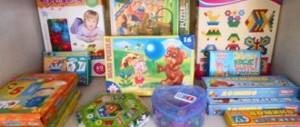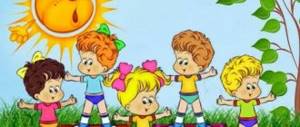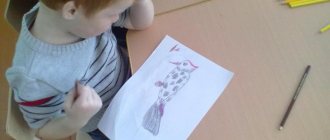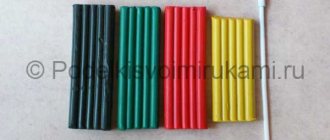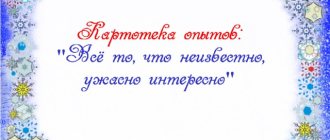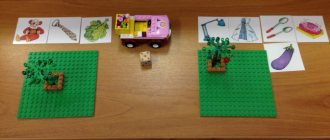Card index educational games for a walk
- Walk and remember - remember objects by walking past them and arrange them in the same sequence.
- One-many - name on the street which item is one and which are many.
- Bring - everyone is given the task to bring a certain number of objects (5 stones, 2 leaves).
- Scouts - the teacher gives the children the task of scouting the territory and counting how many trees grow on the left side and how many dandelions there are near the sandbox.
- Find a pair - one team is given cards with animals, the second is given the same ones. You need to find your mate.
Didactic games for a walk in the preparatory group
- Nature - while walking with children, the teacher pays attention to objects on the playground and asks questions: “What has nature done? What did the man do? Then they compete, naming the longest chain of objects created by nature.
- Name it by letter - the teacher asks the children to name the objects around them on the street with a certain letter: L, T, D, etc. The one who named the most wins.
- Name three objects - the teacher throws a ball to the child during a walk and asks him to name three objects of a certain classification. For example: tree - birch, willow, poplar.
- Add a syllable - the teacher names the syllable and throws the ball to the student, who adds another syllable to form a word, then throws the ball back to the teacher. For example: books, doors.
- Around us - children on a walk must describe what they see around them, consisting of one syllable (garden, ball), two syllables (grass, bushes), three syllables (swing, birch).
Determining the place of a sound in a word
Games to determine the place of a sound in a word are a more difficult stage. During games, children use their voices to identify sounds, practicing clear pronunciation. When working with children, it is worth pronouncing the sound clearly (z-z-hare).
Note! Children must repeat the word and say where the desired sound is. Such exercises are of great importance for teaching children to listen to the sound, to hear the sound, so that they can then easily identify it in a word.
Decorating a speech corner in a kindergarten with your own hands
Didactic games for a walk in the senior group
- Find the same shape - the teacher gives groups of children cards with shapes: square, rectangle, circle. Each group must find the maximum number of objects of the same shape on the site.
- What kind of plant is the teacher gives the child the task to describe the plant or come up with a riddle about it. Condition: the plant grows on a nearby street. The rest are guessing.
- Find what I am describing - the teacher describes the object (plants, toys) in detail, and the children guess and show where this object is located.
- Find a leaf, like on a tree - divide the guys into groups. Then the teacher gives the children time to look at the leaves on the tree, and then look for the same leaves on the ground. Whoever finds more and faster wins.
- Who am I - the teacher points out the vegetation, and the children must say what it refers to (bush, flower, grass, tree).
Progress of the game:
The teacher and children stand in a circle.
Educator. If the leaves turn yellow, this is... (and throws the ball to one of the children. The child catches the ball and says, throwing it back to the teacher: “Autumn”
).
Educator. If the birds fly away, this is... Etc.
31. Didactic game “Be careful”
Goal: differentiation of winter and summer clothing; develop auditory attention, speech hearing; increasing vocabulary.
Listen carefully to the verses about clothing, so that you can then list all the names that appear in these verses. Call it summer first. And then winter.
32. Didactic game “Take - don’t take”
Purpose: differentiation of forest and garden berries; increasing vocabulary on the topic “Berries”
; develop auditory attention.
How to play: Children stand in a circle. The teacher explains that he will pronounce the names of forest and garden berries. If children hear the name of a wild berry, they should sit down, and if they hear the name of a garden berry, they should stretch, raising their arms up.
Strawberries, blackberries, gooseberries, cranberries, red currants, strawberries, black currants, lingonberries, raspberries.
33. Didactic game “What do they plant in the garden?”
Goal: to learn to classify objects according to certain characteristics (by their place of growth, by their use)
; develop quick thinking,
auditory attention.
Progress of the game: Children, do you know what is planted in the garden? Let's play this game: I will name different objects, and you listen carefully. If I name what is planted in the garden, you will answer “Yes”
, if what doesn’t grow in the garden, you say
“No”
. Whoever makes a mistake leaves the game.
· Carrots (yes, cucumber (yes), plum (no, beets (yes)
etc.
· Cherries (yes, gooseberries (yes, potatoes (no)
etc.
34. Didactic game “Who will collect it most quickly?”
Purpose: to teach children to group vegetables and fruits ; cultivate quick reaction to the teacher’s words, endurance and discipline.
Progress of the game: Children are divided into two teams: “Gardeners”
and
"Gardeners"
. On the ground there are models of vegetables and fruits and two baskets. At the command of the teacher, the teams begin to collect vegetables and fruits, each in their own basket. Whoever collects first raises the basket up and is considered the winner.
35. Didactic game “Who needs what?”
Purpose: to exercise in the classification of objects, the ability to name things necessary for people of a certain profession; develop attention.
Educator: - Let's remember what people of different professions need to work. I will name his profession, and you will tell him what he needs for work.
The teacher names a profession, the children say what is needed for work. And then in the second part of the game, the teacher names the object, and the children say for what profession it might be useful.
36. Didactic game “Make no mistake”
Goal: to consolidate children’s knowledge about different sports, to develop resourcefulness, intelligence, and attention; cultivate a desire to play sports.
Progress of the game: The teacher lays out cut pictures depicting various sports: football, hockey, volleyball, gymnastics, rowing. In the middle of the picture is an athlete , you need to pick up everything he needs for the game.
Using this principle, you can make a game in which children will select tools for various professions. Children throughout the year are introduced to the professions: cook, janitor, postman, builder, salesman, doctor, teacher, tractor driver, mechanic, etc. Images are selected for them objects of their labor.
37. Didactic game “Guess it!”
Goal: to learn to describe an object without looking at it, to identify essential features in it, to recognize an object by description; develop memory, speech.
Progress of the game: At the teacher’s signal, the child who received the chip stands up and makes a description of any object from memory, and then passes the chip to the person who will guess. Having guessed, the child describes his item, passes the chip to the next one, etc.
38. Didactic game “Finish the sentence”
Goal: learn to complete sentences with a word of the opposite meaning; develop memory, speech.
Progress of the game: The teacher begins the sentence, and the children finish it, only they say words that are opposite in meaning.
Sugar is sweet and pepper is... (bitter)
In summer the leaves are green, and in autumn -... (yellow)
The road is wide and the path is…. (narrow)
The ice is thin, but the trunk is ... (thick)
39. Didactic game “Where is what?”
Goal: to learn to identify with a given sound a group of words consolidate the correct pronunciation of certain sounds in words; develop attention.
Progress of the game: The teacher names the object and invites the children to answer where they can put it. For example:
- “Mom brought bread and put it in ... (breadbox)
.
· Masha poured sugar... Where? (Into the sugar bowl)
· Vova washed his hands and put down the soap. Where? (On a soap box)
40. Didactic game “Catch up with your shadow”
Purpose: to introduce the concept of light and shadow; develop speech.
Didactic games for a walk in the middle group
- Birds, animals, fish - the teacher throws a ball to the child and asks him to name the bird, animal or fish. Those who could not answer are eliminated.
- Look - the children should see around them objects of the same color or shape, or made of the same material and list them to the teacher.
- What grows - the teacher names shrubs and plants. If they grow in the garden, the children clap; if not, they are silent.
- Animal conversations - the teacher whispers the name of the animal in everyone's ear. At a signal, children take turns giving out the voices of animals (a cat purrs, a lion roars), and others guess.
- Who was who - children look at objects on the site and imagine who was who: an apple - a seed, a cat - a kitten, a wooden swing - a tree, an oak - an acorn.
Didactic games for a walk in the younger group
- Who moves how - the teacher names the animals, and the children together show how this animal moves (a penguin waddles, a frog jumps).
- Complete the drawing - halves of the figures are drawn on the asphalt. You need to finish drawing the other half and say on which side the children added the object, on the right or left.
- Long-short - the teacher gives the children belts made of ribbons, draws attention to the fact that there are short ones and there are long ones. He asks to tie them to objects on the site so that the ribbons barely touch the ground.
- Wide-narrow - a wide and narrow path is drawn on the asphalt. The teacher shows that two toy cars can drive on a wide one, but only one on a narrow one. Children repeat the experiment on paths drawn further away.
- Decorate the asphalt - the teacher invites the children to decorate the circles drawn on the asphalt, but in the same way. The teacher begins, and the children continue: they lay out a circle of leaves, then decorate with flowers in the same way.
Card index of games for the development of sound culture of speech (middle group)
Middle group
Exercises to strengthen correct pronunciation and phonemic awareness
Goals: to develop phonemic hearing, speech attention, speech breathing, to consolidate the correct pronunciation of sounds and words.
Material. Paper boat, 4 cm long; basin with water.
Exercise “Let the boat float on the water”
The basin is half filled with water. Each child, saying: “Foo-oo,” blows on the boat so that it floats from one “shore” to the other.
The exercise is performed 2 times.
Game "Boat and Steamship"
The teacher divides the children into two groups: one group - boats, the other - steamers.
Educator. When a boat floats on the river, you can hear: “Noise, noise, noise”; when there is a ship, you can hear “Tshuh, tsh, tshuh” (children repeat the sound combination).
At the signal “Boats are sailing,” the first group of children walks through the group and pronounces sound combinations: “Shukh, rustling, rustling,” at the signal “Steamboats are sailing,” the second group performs the exercises.
Then the children change roles and the game is repeated.
Train game
Educator. We will go to visit the bear and the bunny by train. I will be the driver, and you will be the carriage driver. The wheels are knocking: “Thump, thump, thump”, the train is humming: “U-oo-oo” (children repeat the sound and sound combination). When the train arrives at the station (the chair on which the bear is sitting, he stops: “Uh-uh, the bear gets on the train and goes to the bunny with the children!” Then the animals and children return to the group.
Game with tasks
The bear gives tasks to the children: “Walk around the room like me” “Growl: “Hrp-hrp-hrp.” “Eat honey - lick it off your paw. lick your lips. teeth in a circular motion" (children perform tasks).
Then the bunny gives tasks to the children: “I am a bunny, call me!” coward. When I get scared, my tail sways from side to side. Show with your tongue how MY tail swings (the children, as the teacher shows, open their mouths wide and, without touching their lips, run their tongue from corner to corner of their mouth). I can jump, and you? (Children jump like a bunny.) I hide behind a bush from the fox (children crouch) and breathe like this: “Uh-uh-uh, uh-uh-uh-uh” (children repeat). Game "Orchestra"
Educator. There are many musicians in the orchestra who play different instruments. And we will only play (on large and small drums.)
Each child is given a small and a large mug; There are the same circles on the board.
Educator. When you hit the big drum, it knocks: “Tam-tam-tatam”; in small - “Tyam-tyam-tytyam” (Children repeat sound combinations 2-3 times.)
- We play big drums (points to a large circle, the children raise the same circle and sing the corresponding song together with the teacher).
- We play small drums (points to a small circle, children raise their mugs and sing another song).
Then the teacher (voluntarily) points to the circles,
Children, raising them, sing the necessary songs.
Exercise “Smell the flower”
Educator. All artists are given flowers. They also gave us a flower. It smells very good. Watch how they smell it (inhale through the nose, exhale without straining your voice and say: “Ah-h-h”).
Then the teacher approaches each child, and he repeats both actions. When everyone has smelled, the teacher invites the children to say the following phrase, first quietly, then louder: “The flower smells so good.”
Exercise "Training"
Educator. Today you will again become artists and play the pipe: “Doo-doo-dududu” (children repeat the sound combination 2-3 times). Let's get ready for the performance: let's puff out our cheeks, as if we have two balls in our mouths (demonstration). Then we’ll blow and say: “Duuu” (repeat 5-6 times)
Game "Orchestra"
Educator. A doll and a bear will help us in the game. If I pick up the doll, the girls will play; if I lift the teddy bear, the boys will play; If I raise the doll and the teddy bear, all the artists - the whole orchestra - will start playing.
The teacher picks up the toys in random order, and the children perform the corresponding actions (9-12 times). At the end of the game, the doll and the bear praise the artists and clap for them.
Didactic games for a walk in winter
- What happens in winter - the teacher asks questions, and the children answer. Do bees fly? - No. Is there snow? - Yes and so on.
- Signs - the teacher talks about signs. If they are about winter, the children clap, if not, they stomp.
- Note and - the teacher hangs notes on trees, bushes, around the site. Children must find and collect the notes while walking quietly. You can't scream and run.
- Gifts - you need to collect winter gifts (icicles, footprints, cones) and tell where they came from (a cone from a spruce tree, icicles from water).
- Along the drawn path , the teacher dictates to everyone geometric shapes that need to be drawn in the snow with footprints.
Didactic games are quite diverse; you can play them at any time of the year. Some of them require certain attributes, so you need to worry about them in advance.

